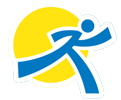Many of you learned valuable insight about your running form through the Gait Analysis Clinic. Good running form helps to prevent injury, minimize wasted energy and helps you to achieve your running goals. Keeping this in mind, it is worthwhile to periodically assess your running form, like you did at the clinic and work to correct imperfections. Running style is determined largely by your biomechanics; the length of your bones, flexibility, strength and endurance of muscles, and the contraction pattern of your muscles as they work together to propel your body forward. The movement and positioning of your legs, arms, torso and head all contribute to your unique running style.
Good running form is particularly important to those running the marathon; flaws become magnified as fatigue sets in and often cause you to tighten up and slow down later on in the marathon. There are several running form imperfections that occur frequently, many of them caused by lifestyle factors such as sitting in front of a computer all day or heavy driving. Others are caused by muscle weakness or tightness. Here are some of the most common running form error and how they can be corrected!
Tight Shoulders, Neck and Upper Back
This is the most common imperfection to running form and is usually caused by spending hours in front of a computer or steering wheel, often leaving the shoulders, neck and upper back tight. This problem also leads to the tendency to hold your shoulders up, and your arms out as you run, keeping your arms from swinging freely back and forth. As a result, you waste energy by using a side to side motion and holding your arms out from your body.
To correct this problem requires eliminating the cause. You can’t quit your desk or driving job, but you can minimize the effects of sitting at a computer or steering wheel all day by taking short breaks every 15 – 20 minutes. This will give you muscles a chance to relax and eliminate chronic tightness. Also check your workstations set up….if the keyboard is too high or low it can have a major effect on posture and muscle tightness. Also check your driving posture in your car….it may be necessary to change the seat and steering wheel position. There are stretches that can help to loosen up tight shoulders, neck and upper back. When you run, concentrate on keeping your shoulders low and relaxed during your run…try to make sure your wrists pass by your waste as you run.
Head In Front of Body
Another common problem caused by hours of sitting in front of a computer is running with your head in front of your body. Your head should be directly over your body, otherwise the muscles in your neck and upper back must constantly contract to keep your head from falling forward. This makes those muscles tight and fatigued.
Moving your computer monitor closer to your chair may help to correct this problem, especially if you are leaning forward all day to read it. Relaxation and Stretching the muscles at the top of your back and neck are usually necessary for correction. An easy way to stretch these muscles is to lie on your back and tuck your chin. Also, concentrate on keeping your head over your body, and have training partners give you feedback….this is a correctable problem!
Arm Tension
Tight shoulders, a tight neck or just bad habit can lead to arm tension. The angle at your elbow should change during the course of a stride….if it is locked, you have tension in your arms. When your arms freely swing, the angle changes with the momentum. Your hands should be relaxed and not held in a fist; this will also cause your arms, neck and shoulders to tighten.
To correct this problem, you need to teach your arm muscles to relax, requiring a conscious effort and concentration. Stretch and relax your shoulders and arms before each run, and remind yourself during the run to relax your arms. It may take a little while, but eventually your arms should stay more relaxed during the runs.
Leaning Forward
Leaning forward at the waist while running causes your torso and quadriceps muscles to work harder and result in early fatigue and soreness. This can be caused by poor posture while sitting and some runners may actually do it because they believe it is correct running form.
In order to eliminate a forward lean, it is important to strengthen your core …your gluteal and abdominal muscles, as well as a conscious effort to correct the problem. This often requires working with a physical therapist or athletic trainer on core strengthening exercises are often required.
Instability in Trunk
Some runners waste energy by twisting their trunk as they run. This is because the energy isn’t being channeled into moving forward. Like leaning forward, instability in the trunk is caused by weak lower abdominal and gluteal muscles and is corrected by core strengthening exercises.
Excessive Vertical Movement
Vertical Motion is greater for shorter races than the marathon…the best marathoners have a very small amount of vertical movement in their stride, staying close to the ground. If you have too much vertical movement, you are wasting energy that could be used to move you forward rather than up!.
This problem can be corrected by improving your core strength and by stretching your calf muscles. Think about gliding as you run!
Overstriding
Most runners naturally select the stride length that is correct for them. Usually when a runner over strides, it is because they are intentionally doing so, thinking it may help to improve their running. It actually wastes energy! The best way to increase stride length naturally is by increasing strength and flexibility. To correct over striding, try to follow Jimmy Webber’s lead….yes that’s right! Run Barefoot! It is very difficult to over stride while running barefoot! Try running a few hundred meters barefoot several times a week, and eventually you will find your natural stride!
Feet Pointing Out
Energy is also wasted by running with your feet pointed outward, away from your line of motion. Some of this is caused by genetic factors, but the problem can also have correctable causes. If your gluteal muscles are weak and tight, or if your hip flexors are tight, this can cause your fee to point to the outside. Take a look at your footprints running through mud or snow, or after running through a puddle. If they point to the outside, try strengthening and stretching your gluteals and stretching your hip flexors!
Pfitzinger, P., and S. Douglas. 2001. Advanced Marathoning. Champaign, IL: Human Kinetics.




